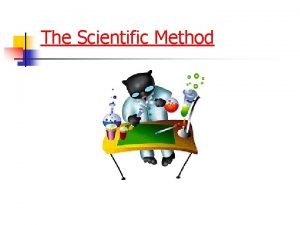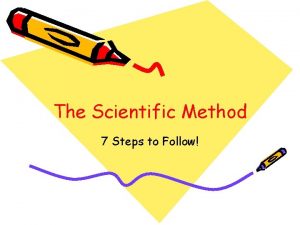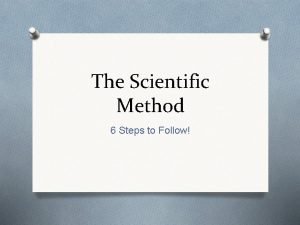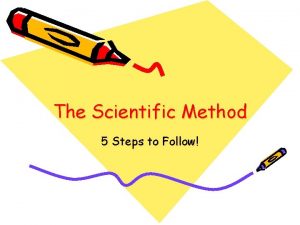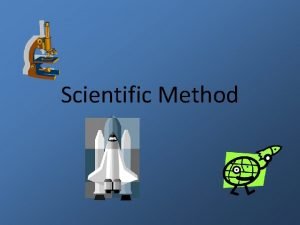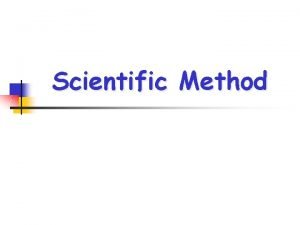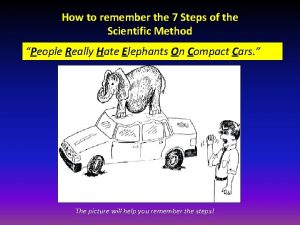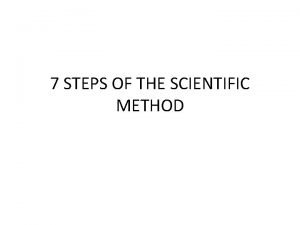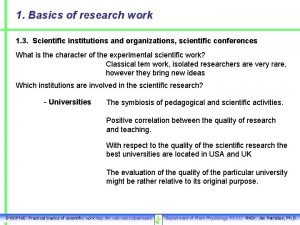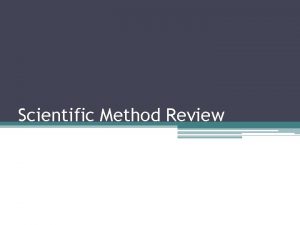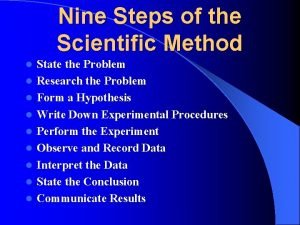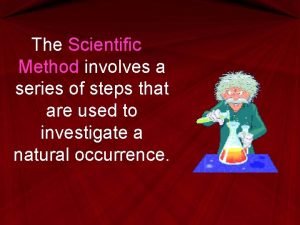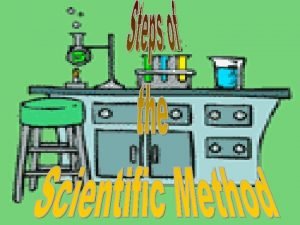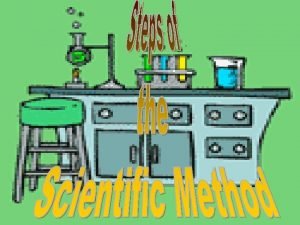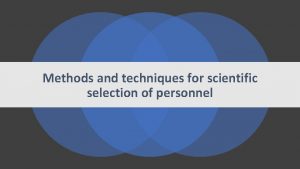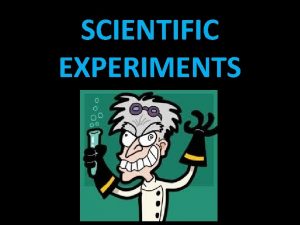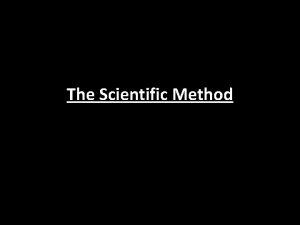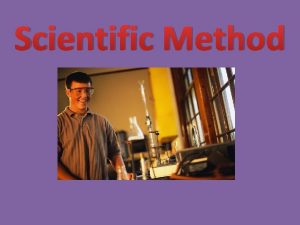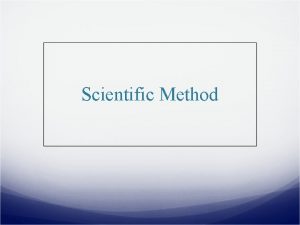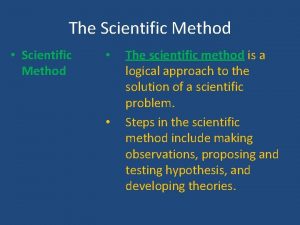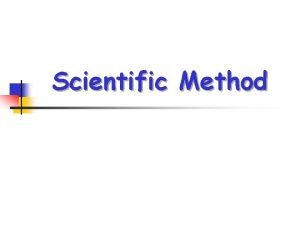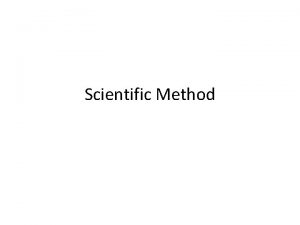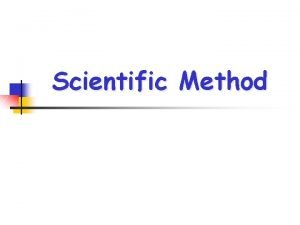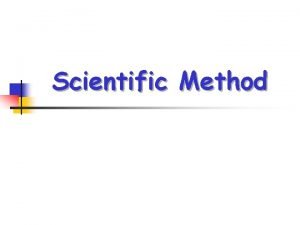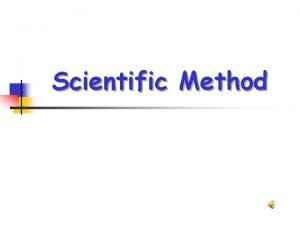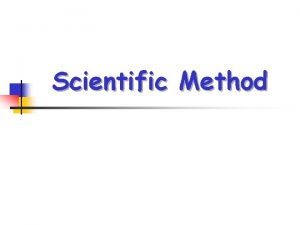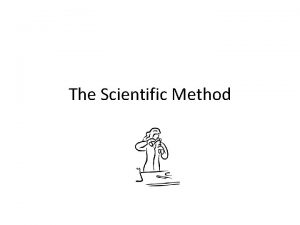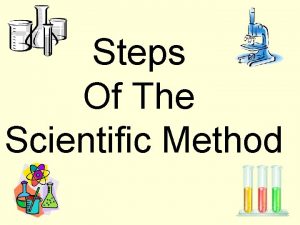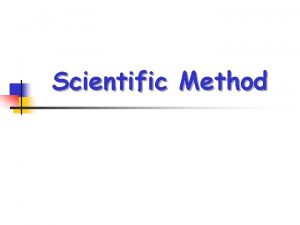Scientific Method Steps in the Scientific Method n





























- Slides: 29

Scientific Method

Steps in the Scientific Method n n n n Observation Ask a question Research/Gather information Hypothesis Experiment Conclusion Retest Real World Application

Observations n n Gathered through your senses A scientist notices something in their natural world

Observations n An example of an observation might be noticing that many salamanders near a pond have curved, not straight, tails

Ask a question n n Observations lead to a question that you would like to have answered. Example: Why are the salamander tails curved?

Gather Information n n Research should be collected in order to help you find a possible solution to the problem. For example: you might want to research salamanders, the environment in which they live, and make additional observations about the pond.

Hypothesis n n A suggested solution to the problem. Must be testable Sometimes written as If…Then… statements Predicts an outcome

Hypothesis n An example of a hypothesis might be that the salamanders have curved tails due to a pollutant in the moist soil where they live.

Experiment n A procedure to test the hypothesis.

Scientific Experiments Follow Rules n An experimenter changes ONE factor called a variable and observes or measures what happens.

Experimental Group n n The group that contains the one variable that is being changed or tested is called the experimental group. The group that does not include the variable being tested is called the control group.

The Control Variable The experimenter makes a special effort to keep other factors constant so that they will not affect the outcome. n Those factors are called control variables. n

What is the Purpose of a Control? Controls are NOT being tested n Controls are used for COMPARISON n

Other Variables n n The factor that is changed is known as the independent variable or manipulated variable. The factor that is measured or observed is called the dependent variable or responding variable.

Example of Controls & Variables n n n For example, suppose you want to figure out the fastest route to walk home from school. You will try several different routes and time how long it takes you to get home by each one. Since you are only interested in finding a route that is fastest for you, you will do the walking yourself.

What are the Variables in Your Experiment? Varying the route is the independent variable n The time it takes is the dependent variable n Keeping the same walker throughout makes the walker a control variable. n

One more thing… it is best to make several trials with each independent variable.

Remember: To be a Valid Experiment: Two groups are required --- the control & experimental groups n There should be only one manipulated variable n

Data Results of the experiment n May be quantitative (numbers) or qualitative n

Data Must be organized n Can be organized into charts, tables, or graphs n

Conclusion n A judgement based on the data obtained from the experiment

Retest In order to verify the results, experiments must be retested and hypotheses revised. n Once a hypothesis has been verified several times a theory is formed. n

Theory and Law n n Theory – An explanation that has been supported by many experiments Law – A theory that has been proven to be true all the time under a set of exact conditions

Solving a Problem 1) Make Observations 1)Identify a Problem 2) Gather Information about the problem 3) Form a Hypothesis about the problem (if…then…) 4) Design an Experiment to test the hypothesis 5) Form a Conclusion 6) Retest 7) Form a theory

Irma wants to know how UV Radiation affects cultures of bacteria. She sets up two groups. One group stays in the incubator, and one group stays under a UV lamp. Both groups are the same species of bacteria, grown on the same media, and are held at the same temperature. Independent Variable: Dependent Variable: Experimental Group: Control Group: Constants:

Beverly wants to know how salt affects the boiling point of water. She boils two pots of water. In one, she adds a tablespoon of salt, and in the other, she puts nothing. She measures the temperature at which both pots boil. Both pots are identical. Independent Variable: Dependent Variable: Experimental Group: Control Group: Constants:

Emily is testing a certain vitamin supplement to see if it will make her jump higher. She records her jump height with an electronic jump machine every day for two weeks. Then she takes two weeks off and begins the vitamin supplement. Then she continues the vitamin supplement and records her jump height every day for the next two weeks. Independent Variable: Dependent Variable: Experimental Group: Control Group: Constants:

Susan wants to know if a new and improved brand of fish food will help her goldfish to grow faster. She divides her fish into two tanks. One tank of fish receive the new and improved brand of food and the other group receives the old brand of food. Independent Variable: Dependent Variable: Experimental Group: Control Group: Constants:

Gene wants to know if a certain type of sports drink replenishes the number of electrolytes in athletes’ bloodstreams. He divides a group of athletes in half. To one half he gives Powerade sports drink, and to the other half he gives water. Thirty minutes after drinking their beverage, he draws blood and checks for electrolytes. All athletes were the same age and involved in the same activity prior to having their blood drawn. Independent Variable: Dependent Variable: Experimental Group: Control Group: Constants:
 7 steps of the scientific method
7 steps of the scientific method 7 steps of the scientific method
7 steps of the scientific method Scientific method 7 steps
Scientific method 7 steps List 6 steps of the scientific method
List 6 steps of the scientific method What are the 5 steps in the scientific method
What are the 5 steps in the scientific method Steps of scientific method
Steps of scientific method Scientific method steps
Scientific method steps Scientific method 5 steps
Scientific method 5 steps How to remember the 7 steps of the scientific method
How to remember the 7 steps of the scientific method What are the 7 steps of the scientific method
What are the 7 steps of the scientific method Steps of scientific method
Steps of scientific method What are the six steps of the scientific method
What are the six steps of the scientific method Nine steps of the scientific method
Nine steps of the scientific method Scientific method steps
Scientific method steps Scientific method steps
Scientific method steps Scientific method steps
Scientific method steps Scientific method steps
Scientific method steps Information gathered during an experiment
Information gathered during an experiment Axial movements examples with pictures
Axial movements examples with pictures Scientific experiment steps
Scientific experiment steps Scientific selection procedure
Scientific selection procedure Hình ảnh bộ gõ cơ thể búng tay
Hình ảnh bộ gõ cơ thể búng tay Lp html
Lp html Bổ thể
Bổ thể Tỉ lệ cơ thể trẻ em
Tỉ lệ cơ thể trẻ em Voi kéo gỗ như thế nào
Voi kéo gỗ như thế nào Tư thế worm breton là gì
Tư thế worm breton là gì Chúa sống lại
Chúa sống lại Môn thể thao bắt đầu bằng chữ f
Môn thể thao bắt đầu bằng chữ f Thế nào là hệ số cao nhất
Thế nào là hệ số cao nhất
